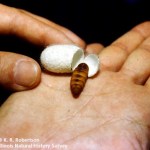hearing loss
First of five student guest posts by Kristen Coleman
Every morning as I prepare for class, I go through the same internal dialogue, “to wear or not to wear my hearing aide.” I am forced to do this because when I was a child I, like most American children (about 80% by age 3 as estimated by the American Academy of Family Practitioners, AAFP), suffered from otitis media and my treatment resulted in hearing loss. The treatment I underwent was called tympanostomy with ventilation tube insertion, which has rapidly become the most common reason for general anesthesia in children in the United…
Dr. Marcus Atlas, from the Ear Science Institute in Australia, and his team have pioneered a novel treatment for repairing damaged eardrums using silk obtained from silkworm cocoons, like the one pictured above.
Damage to the auditory nerve connecting the inner ear and brain causes hearing loss in some individuals. Researchers Dr. Marcelo Rivolta from the University of Sheffield and colleagues have shown that human embryonic stem cells that were differentiated into auditory nerve cells can improve overall by ~45% hearing in gerbils that were treated with ouabain to damage the nerves. Ten weeks after transplantation, some of the differentiated cells were shown to grow projections that connected with the brain stem and the animals could perceive more faint sounds.
Of course the purpose…
Mumps was a common childhood disease when I was a child. We grew up learning that it was better to get mumps as a child because getting it as an adult would make you sterile. No doubt that idea arose from symptoms like swollen glands, swollen testicles, etc. When I looked in PubMed though, I couldn't find much data on sterility (at least not easily).
I did find data on hearing loss.
Death is not a common outcome of mumps. Between 1953 and 1962, there were 162,344 cases of mumps in the U.S. every year and only 39 deaths per year. People, mostly children, did die from mumps, but other…
